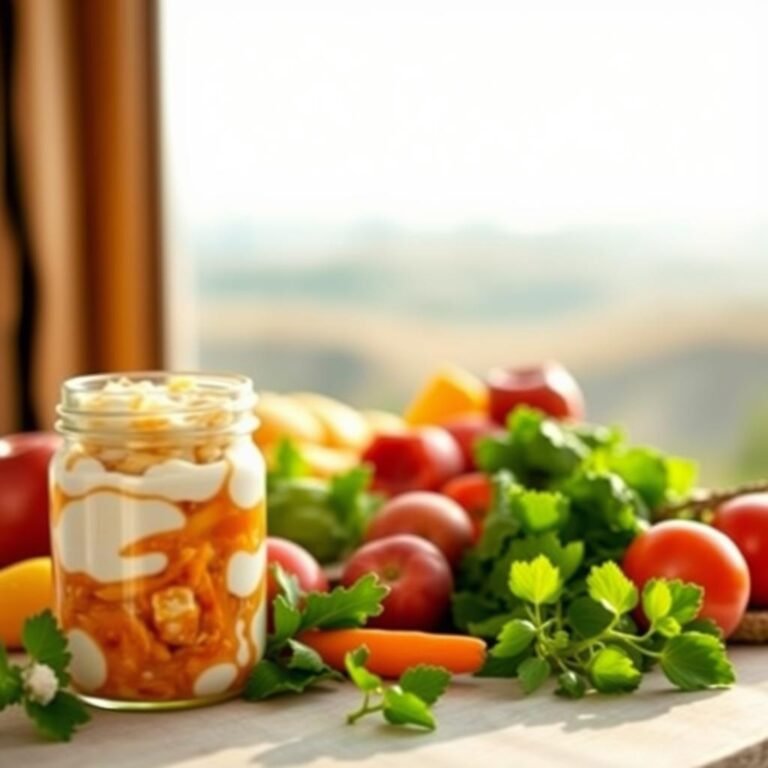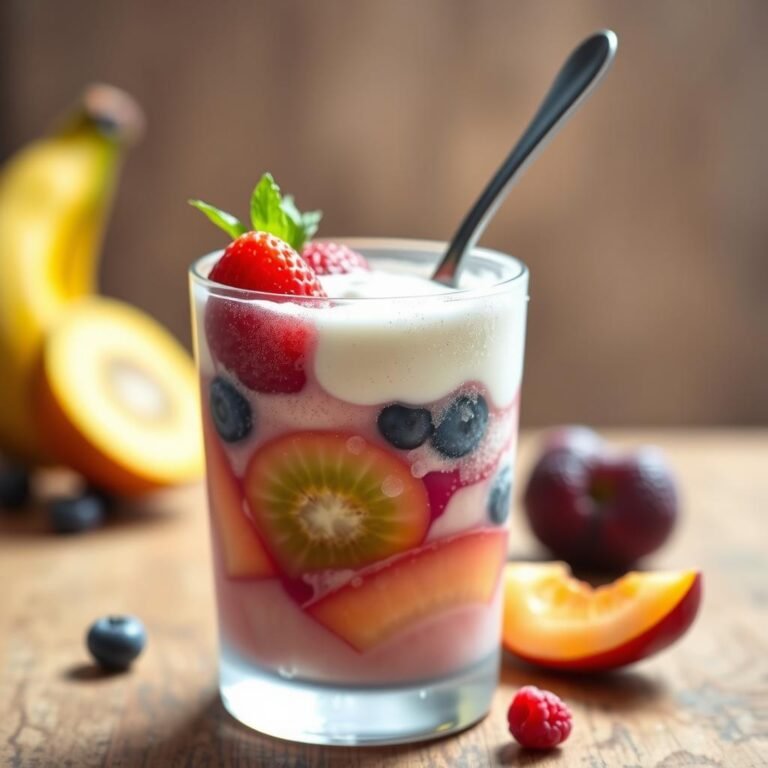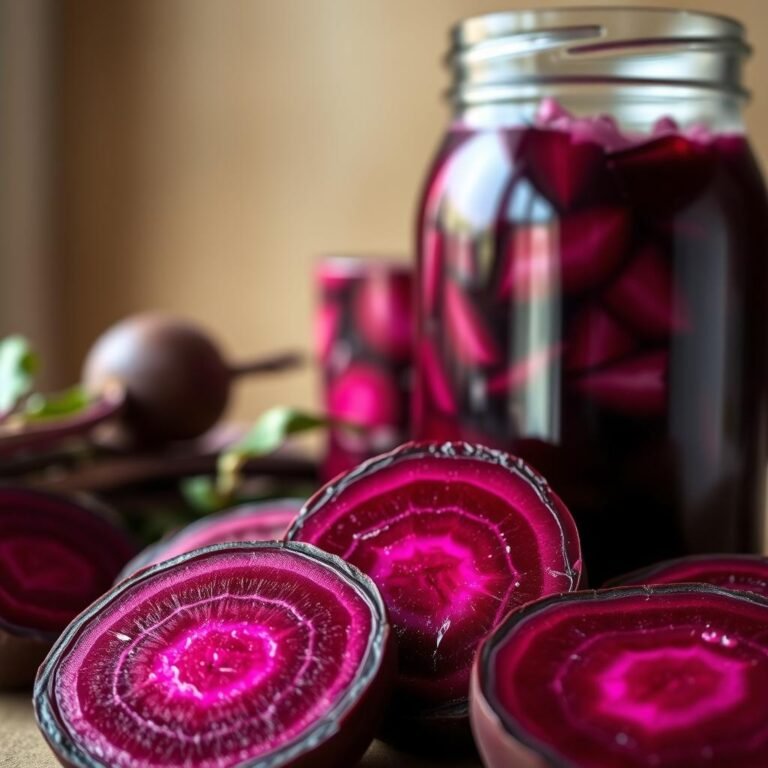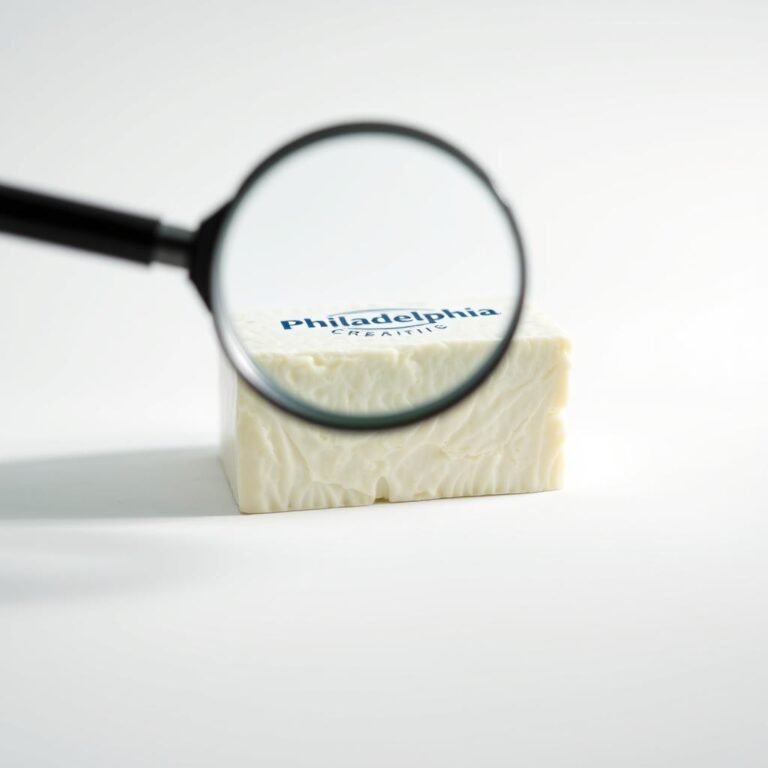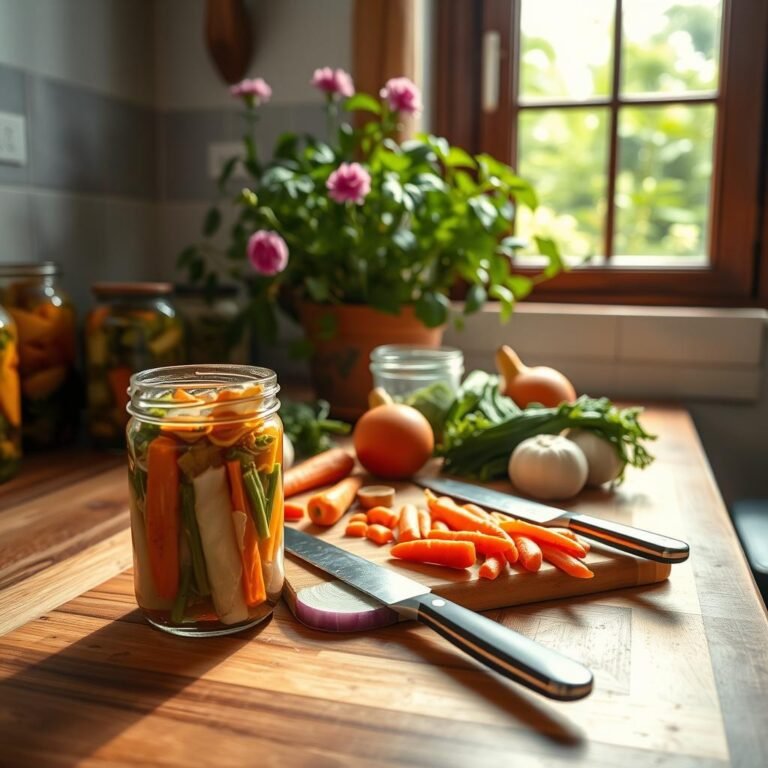How to Make Fermented Beetroot That’s Great for Your Gut
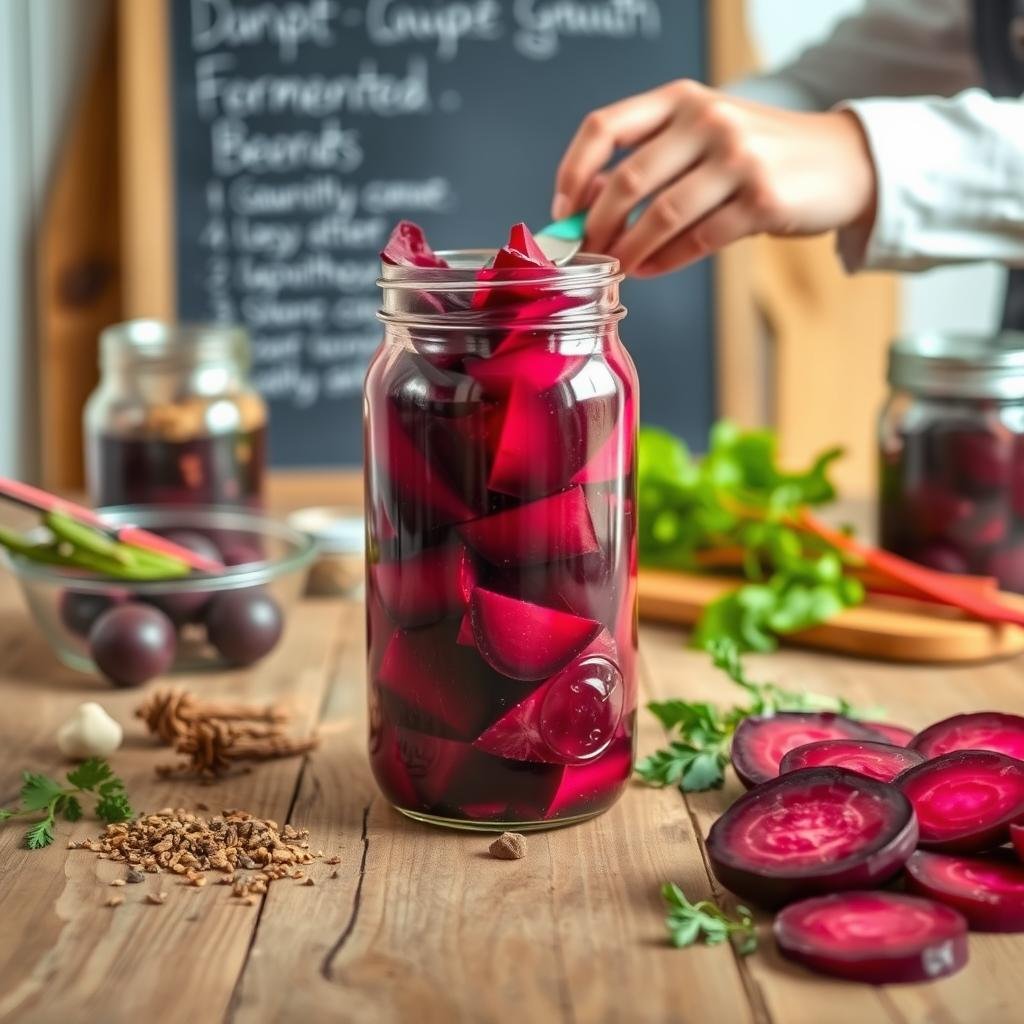
Learn how to make fermented beetroot, a superfood for your gut. This recipe, called Beet Kvass, comes from Eastern Europe. It’s packed with probiotics and is easy to make with just beets, sea salt, and water.
Fermented beetroot adds a unique taste to your food. It’s great for digestion and boosts your immune system. We’ll show you how to make it at home. This guide is perfect for beginners and experts alike.
What Is Fermented Beetroot?
Fermented beetroot, also called Beet Kvass, is a healthy drink. It goes through a process called lacto-fermentation. This makes it even better for your health.
Nutritional Benefits
Beetroot is full of good stuff like potassium, betaine, magnesium, and folate. Fermenting it makes these nutrients even easier for your body to use. It also adds probiotics, which help your gut.
This drink also gets more vitamin C and manganese. So, it’s packed with nutrients.
- Rich in potassium, magnesium, and folate
- Boosted with Vitamin C and manganese
- Enhanced with probiotics for better digestion
The Science Behind Fermentation
Fermentation is really cool. It turns beetroot’s sugars into lactic acid with the help of good bacteria. Here’s how it happens:
Learn more about the stagesof.
| Timeframe | Stage | Microbial Activity |
|---|---|---|
| 24-48 hours | Initial fermentation | Gram-negative bacteria and opportunistic pathogens are present. |
| 48 hours – 10 days | Active fermentation | Leuconostoc bacteria thrive, producing bubbles as Gram-negative organisms die off. |
| 10-14 days | Mid fermentation | The ferment becomes cloudy as Lactobacillus species begin to thrive. |
| 14-21 days | Final fermentation | Lactobacillus dominates, producing lactic acid and preserving the mixture. |
This change makes beetroot easier to digest and more nutritious. It keeps its tasty flavor and health perks. So, it’s great for your diet.
Why Ferment Beetroot at Home?
Fermenting beetroot at home has many benefits. It’s a fun way to save money and enjoy better flavors.
Cost-Effectiveness
One big plus is saving money. You can make a lot of beetroot at home with just a few ingredients. This is cheaper than buying it from stores.
It’s perfect for those who want to save money but don’t want to give up taste.
Enhanced Flavor Profiles
Fermenting beetroot makes it taste even better. The long fermentation time changes the beets’ sweet taste into something tangy and complex. It’s a unique and tasty flavor.
Control Over Ingredients
When you ferment at home, you choose what goes in. You avoid chemicals and preservatives. This keeps your beetroot healthy and full of nutrients.
Having control means you get a better, more natural product.
Ingredients Needed for Fermentation
Choosing the right ingredients for beetroot fermentation is key. This guide will help you pick the best parts for a tasty ferment.
Fresh Beetroot Selection
Always pick organic beets to avoid pesticides. Both red and yellow beets are great for their nutrients and color. Make sure they are fresh, firm, and without blemishes.
Salt Requirements
A good salt guide is essential for a great ferment. Use fine sea salt for its purity and minerals. Add 1 to 3 tablespoons of salt per quart of water, based on your taste.
Optional Flavor Additions
Adding optional flavors can make your beetroot ferment even better. Try herbs like dill and thyme, or spices like coriander and mustard seeds. A bit of whey or brine can also change the taste. Mix and match to find your favorite flavor.
Preparing the Beetroot for Fermentation
Getting beetroot ready for fermentation is key. You need to wash, peel, cut, and salt them. These steps help the beets ferment well and taste great. Let’s look at each step to understand it better.
Washing and Peeling
Start by washing the beets well with cold water. This removes dirt and debris. You can peel them for a smoother taste or leave the skins on for a rustic flavor.
Use a vegetable brush to clean the beets if you don’t peel them.
Cutting Techniques
After washing and peeling, cut the beets. Cutting them into cubes or slices helps them absorb salt better. This is important for even fermentation and flavor.
Salting the Beets
Salting is the final step. Mix the cut beets with a saltwater brine. Use about 1 tablespoon of salt for every 2 cups of water.
Make sure the beets are fully coated with the salt mixture. This starts the fermentation. You can add spices to make the flavor better. The salt helps draw out juices from the beets, creating a brine for fermentation.
The Fermentation Process Explained
Learning how to ferment beetroot is key to making tasty and healthy food. Knowing the right fermentation techniques and keeping the right optimal fermentation conditions is important.
Choosing a Fermentation Vessel
Choosing the right container is a big step. Glass jars are best because they don’t react with food. This keeps your beets safe from harmful chemicals. Mason jars are a favorite among many.
Temperature and Time Guidelines
Keeping the temperature steady is very important. The best temperature for fermenting beetroot is between 60-65 degrees Fahrenheit. The time it takes varies, from 5 to 21 days, depending on how tangy you like it.
It’s important to check on your ferment often. This helps avoid it getting too sour. By following these fermentation techniques, you can make sure your ferment turns out right.
Safety Precautions for Fermentation
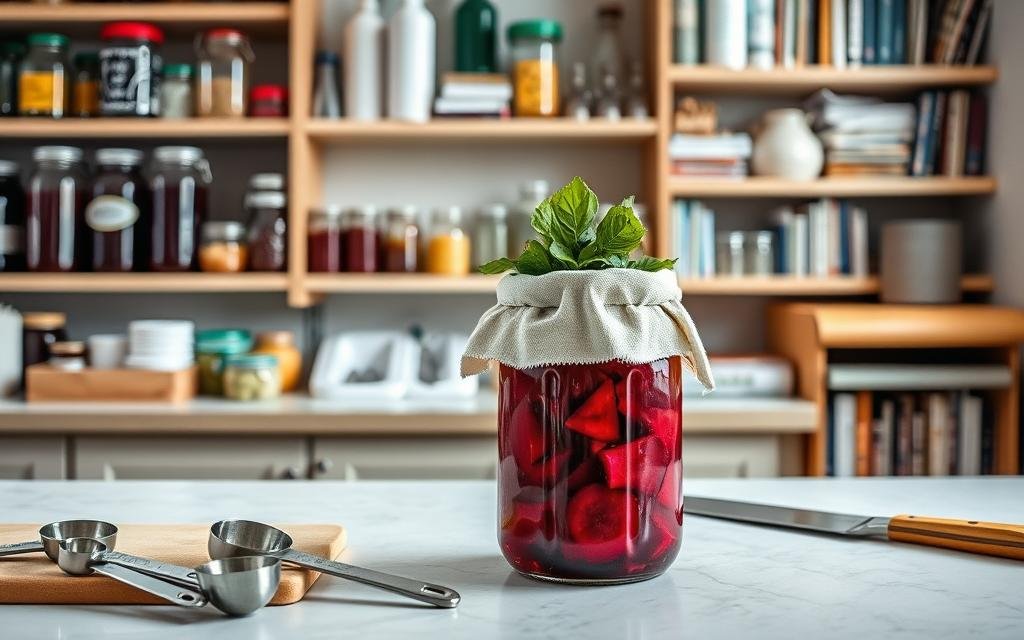
Keeping safe during fermentation is key to avoid health problems from bad food. Here’s how to follow safe fermentation steps and stop contamination.
Recognizing Spoilage
Knowing when fermentation goes wrong is important. Watch for mold, bad smells, and tastes that don’t taste right. These signs mean something’s gone wrong, helping stop contamination.
Proper Hygiene Practices
Good hygiene is essential for safe fermentation. Start by cleaning all tools and containers well. Make sure your hands are clean and work in a clean area. Keeping your fermentation space clean helps avoid harmful bacteria, stopping contamination.
Flavor Variations to Try
Customizing fermented beetroot is fun because you can try new flavors. You can mix herbs, spices, and fruits to make unique beet Kvass. This way, you can find the perfect taste for you, whether you like savory or sweet.
Adding Herbs and Spices
Adding herbs and spices can make your beetroot taste amazing. Here are some great mixes to try:
- Sweet cinnamon beets: 1 cinnamon stick and 3 whole cloves
- Traditional pickle: 1 tablespoon pickling spice, 2 cloves of garlic, and a flowering head of fresh dill
- Caraway: 2 teaspoons caraway and 5 black peppercorns
- Garlic: 1-2 cloves of garlic per jar
- Hot and spicy: 1 or 2 hot peppers, sliced in half with seeds
These mixes can turn your beets into a tasty treat. They’re great with many dishes. For more ideas, see this resource on spice combinations.
Sweetening with Fruits
For a sweeter taste, try adding fruits to your beetroot. Fruits like apples, berries, or citrus add sweetness and match beets well. Here are some ideas:
- Apple slices: Adds a mild sweetness and crisp texture
- Mixed berries: Provides a tangy and vibrant twist
- Oranges: Introduce a zesty and fresh citrus note
Trying these mixes can make your beet Kvass taste amazing. It also brings health benefits. Making your beetroot taste just right opens up a world of possibilities.
How to Store Fermented Beetroot
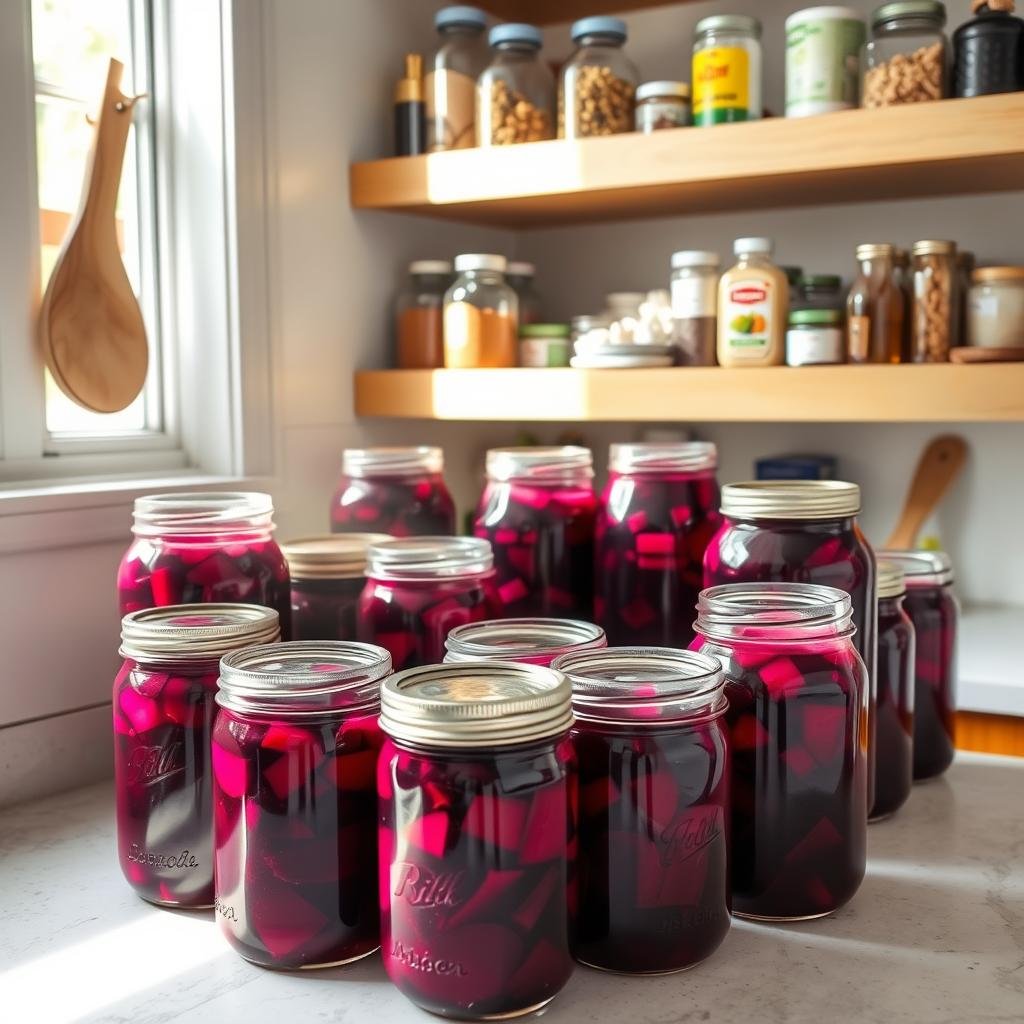
Storing fermented beetroot right is key to keeping its taste and freshness. It’s important to keep air out and keep the temperature steady. Glass jars with tight lids are perfect for this. Proper storage lets you enjoy your fermented beets for weeks or months.
Glass Jar Options
Choosing glass jars is a top choice for storing fermented beets. These jars need airtight lids to block air, which can ruin the beets. Glass is safe and keeps the beet’s taste and nutrients. Look for jars made for canning, like those from Ball or Mason.
Refrigeration Tips
After fermentation, chill the beets. Cold storage slows down fermentation, keeping the beets fresh longer. Keep jars in the fridge’s coldest spot, at 32°F to 40°F. This keeps your fermented beets tasty for months.
| Storage Method | Pros | Cons |
|---|---|---|
| Glass Jars |
- Airtight seal
- Non-reactive material
- Preserves flavor
- Can break if dropped
- Heavier than plastic
| Refrigeration |
- Slows fermentation
- Prolongs shelf life
- Maintains crispness
- Takes up fridge space
By following these storage tips, you can enjoy fermented beetroot’s rich taste and health benefits for longer. The main thing is to keep air out and keep it cool.
Using Fermented Beetroot in Recipes
Fermented beetroot is great for many dishes. It adds a tangy flavor and health benefits. It makes your meals taste unique and healthier. Here are some ideas to start your cooking journey.
Salads and Side Dishes
Fermented beetroot makes salads and sides tangy. It’s full of live probiotics, making your meals better. Try it in potato salad or with arugula, goat cheese, and walnuts for a fancy dish. You can also mix it with quinoa, spinach, and nuts for a tasty salad.
Smoothies and Juices
Fermented beetroot is amazing in smoothies and juices. It adds flavor and probiotics. Blend it with berries, banana, and almond milk for a healthy smoothie. Or mix it with carrots, apples, and ginger for a detoxifying juice.
For more tips, check out this recipe on making fermented beetroot.
Health Benefits of Fermented Foods

Fermented foods, like beetroot, are full of good bacteria. These microbes help our gut and digestion a lot.
Gut Health Contributions
Fermented foods are great for our gut thanks to the probiotics. These good bacteria keep our gut balanced. They help us digest food better and absorb nutrients.
Fermented beet juice, for example, boosts gut health and metabolism. This is shown in studies.
Immune System Support
Eating fermented foods helps our gut and boosts our immune system. They make nutrients more available and help our body’s defenses. Fermented beets, being low FODMAP, help keep our bowel healthy.
This support shows how fermented foods help our overall health. They are good for us in many ways.
Common Mistakes to Avoid
Starting with fermenting beetroot? Avoiding common mistakes is key for success. One big error is over-salting. Too much salt slows down fermentation and changes the taste.
Getting the right salt-to-water ratio is very important. It helps your beetroot turn out perfectly.
Over-Salting Issues
Salting right is important for good fermentation. It helps good bacteria grow and keeps bad ones away. The right amount of salt is essential for a tangy taste and keeping nutrients.
Make sure your ingredients stay covered during fermentation. This stops oxygen from getting in and causing spoilage. For more on common mistakes, like over-salting, check out reliable sources. Be patient, as fermentation takes 7-14 days or up to 28 days. This time is needed for the best flavor and health benefits.
